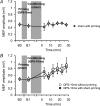Primary motor cortical metaplasticity induced by priming over the supplementary motor area
- PMID: 19723779
- PMCID: PMC2770151
- DOI: 10.1113/jphysiol.2009.179101
Primary motor cortical metaplasticity induced by priming over the supplementary motor area
Abstract
Motor cortical plasticity induced by repetitive transcranial magnetic stimulation (rTMS) sometimes depends on the prior history of neuronal activity. These effects of preceding stimulation on subsequent rTMS-induced plasticity have been suggested to share a similar mechanism to that of metaplasticity, a homeostatic regulation of synaptic plasticity. To explore metaplasticity in humans, many investigations have used designs in which both priming and conditioning are applied over the primary motor cortex (M1), but the effects of priming stimulation over other motor-related cortical areas have not been well documented. Since the supplementary motor area (SMA) has anatomical and functional cortico-cortical connections with M1, here we studied the homeostatic effects of priming stimulation over the SMA on subsequent rTMS-induced plasticity of M1. For priming and subsequent conditioning, we employed a new rTMS protocol, quadripulse stimulation (QPS), which produces a broad range of motor cortical plasticity depending on the interval of the pulses within a burst. The plastic changes induced by QPS at various intervals were altered by priming stimulation over the SMA, which did not change motor-evoked potential sizes on its own but specifically modulated the excitatory I-wave circuits. The data support the view that the homeostatic changes are mediated via mechanisms of metaplasticity and highlight an important interplay between M1 and SMA regarding homeostatic plasticity in humans.
Figures








References
-
- Abbott LF, Nelson SB. Synaptic plasticity: taming the beast. Nat Neurosci. 2000;3:1178–1183. - PubMed
-
- Abraham WC. Metaplasticity: tuning synapses and networks for plasticity. Nat Rev Neurosci. 2008;9:387–399. - PubMed
-
- Abraham WC, Bear MF. Metaplasticity: the plasticity of synaptic plasticity. Trends Neurosci. 1996;19:126–130. - PubMed
-
- Abraham WC, Huggett A. Induction and reversal of long-term potentiation by repeated high-frequency stimulation in rat hippocampal slices. Hippocampus. 1997;7:137–145. - PubMed
Publication types
MeSH terms
LinkOut - more resources
Full Text Sources

